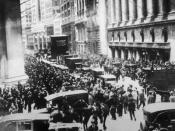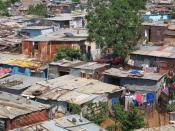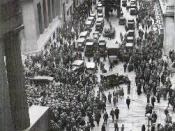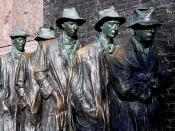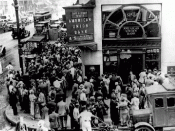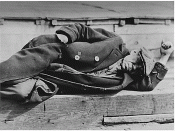The Great Depression began in October of 1929 and didn't end until the late 1930s. It severely affected many nations and Australia was not left out. The Great Depression impacted on Australia and its population politically, socially and economically.
The catastrophe was caused by five main reasons. The initial event that triggered the depression was the crash on Wall Street stock exchange in New York. It began when investors started selling their shares at panic proportions and sold them at drastically reduced prices. Thousands of investors and companies went bankrupt. Australia also borrowed millions of pounds from overseas so when the depression struck, countries that lended the money such as Britain required their outstanding loans to be repaid. Cycles of boom and slump, overproduction and poor government also triggered theThe Great Depression's impact on Australian society was devastating. The social impacts included unemployment, evictions, the "susso", jumping the rattler and susso camps or shanty towns.
Unemployment was one of the major problems caused by the Great Depression. Businesses and exports came to a dramatic decline resulting in sudden and widespread unemployment. Thousands of employed Australians who had some form of financial security suddenly lost their jobs and unemployment rates sky rocketed to more than 30 percent in 1930. Without work and a steady income many people got evicted from their homes and were forced to live in makeshift dwellings made from cardboard, sheets of corrugated iron, hessian cloth and anything they could find in areas of waste ground on the outskirts of cities called shanty towns. Some of the well-known shanty towns were Happy Valley at Le Perouse and Brighton - le - Sands.
The Commonwealth government were slow to assist and eventually gave the unemployed sustenance payments called the "susso" and Australians called it "being on the susso". The "susso" payment was in the form of ration tickets and could be exchanged at allocated shops for food. There was no susso for rent, electricity or clothing and no money was given. However, men applying for the susso felt humiliated as they had to queue for hours and suffer the indignity of being questions about private affairs. Others were just too proud to accept the susso.
The government occasionally provide relief work on a temporary basis. Payment was always below the wage and men were required to work on state and council buildings. The relief work was know as "working for the dole" and men who rejected it would have their susso payments cut off. The relief work was just a way for the government to force their people into doing jobs that benefited them. Many Australians hated it and tried desperately to look for their own jobs. Men walked all over the city and when a job did become available, they would all turn up to claim it. Other men would "jump the rattler". This was hitching free rides on trains in search for work. This was both illegal and dangerous.
If life was humiliating and hopeless for men, it was even worse for the women. Men could escape by doing relief work or "jumping the rattler". On the other hand, women had to stay home and feed, clothe and educate their children and also enter the workforce. They were considered the breadwinner and home-maker of the family and this was a great burden as men still expected them to care for the family and work. Female labour was cheap and unfair and was only 54 percent of a man's wage. This meant that women's wage were not adequate to support the family.
Children suffered just as much as their parents. Many working-class children were forced to leave school at an early age of thirteen or fourteen years and find work. Children were paid even less than women but had a higher chance of finding odd jobs such as crawling into machines. However, their jobs were highly dangerous. This meant that their childhood was one without sweet memories and lacking adequate food, clothing, housing and toys.
However, it was a completely different experience for the rich and employed. The rich were mostly unaffected by the Depression and even had a more improved lifestyle. The wealthy continued living in the high-class suburbs, taking holidays overseas, buying the latest car and having their children attending private schools.
The middle class Australians who managed to keep their jobs were able to buy houses and companies from people who had fallen on hard times and their standard of living also increased.
BibliographyRetroactive 2 textbookhttp://www.cultureandrecreation.gov.au/articles/greatdepression/
